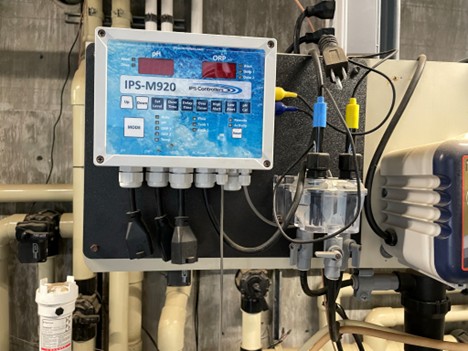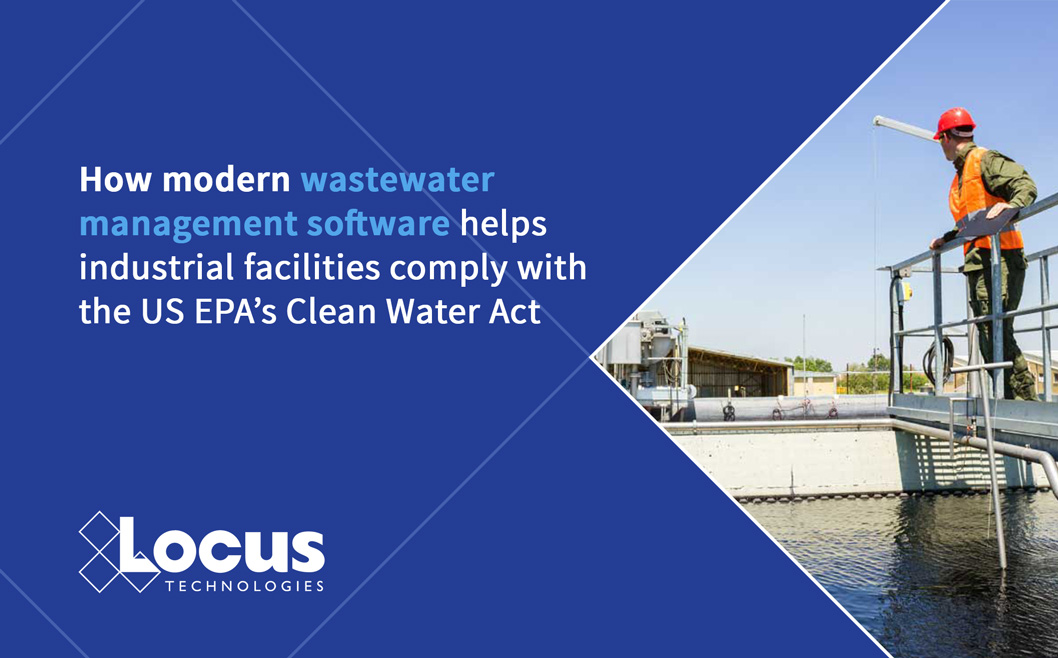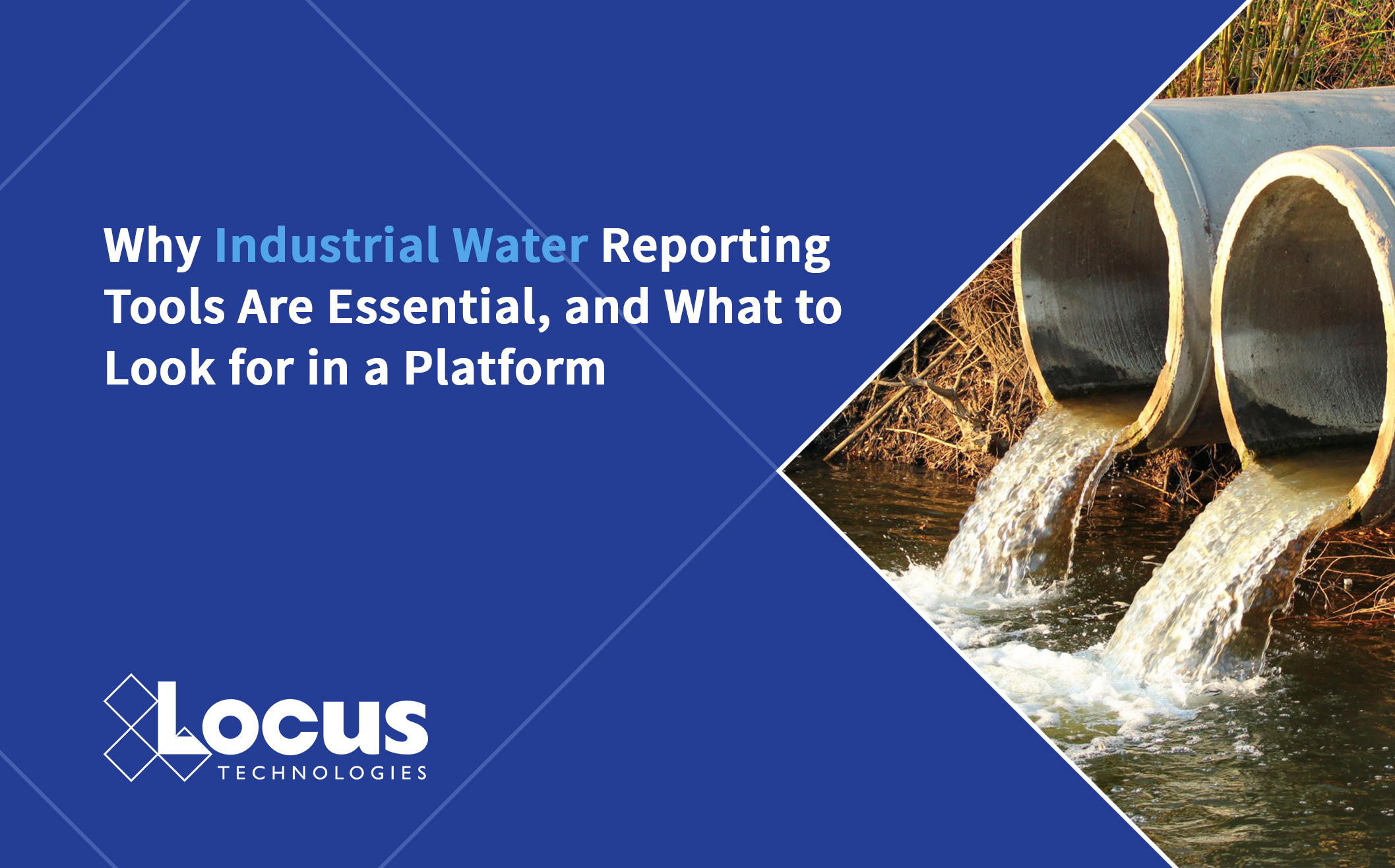
TL;DR There isn’t enough time in the day to accomplish your to-do list, let alone time to research time savers. So, let’s cut to the chase. We’ve outlined exactly what to look for in industrial water reporting software to make EHS compliance and sustainability reporting easier. The highlights include: flexible integrations to unite all data sources, permit tracking and tasking, support for samples and analytical data, spatial and visual analytics, audit controls, configurable reports, scalability and adaptability. That’s a lot. Let’s dig in.
Industrial water reporting software helps manage risk, reduce costs, and improve sustainability performance
In today’s regulatory and ESG-conscious environment, industrial water reporting tools are a mission-critical component of environmental compliance and resource management strategies for manufacturers and industrial companies.
From the complexities of NPDES permits to stakeholder expectations around water stewardship, companies face increasing pressure to track, report, and optimize water use and discharge across facilities and operations. Accurate, real-time water data is not just about remaining compliant; it’s about managing risk, reducing costs, and improving sustainability performance.
This article explores why water reporting tools are so essential for industrial sectors, and the features EHS professionals should prioritize when selecting a solution.

Why water reporting matters to industry
-
Regulatory Compliance
Industrial operations often fall under stringent water-related regulations, such as:
- National Pollutant Discharge Elimination System (NPDES) permits.
- Stormwater Pollution Prevention Plans (SWPPPs).
- Industrial Wastewater Discharge Permits.
- State-level water use and quality regulations.
Failure to comply can lead to fines, shutdowns, and reputational damage. Manual tracking methods and siloed data systems increase the risk of missing reporting deadlines, misreporting discharge volumes, or exceeding permit limits. Locus software can help.
-
Water Scarcity and Resource Risk
In many regions of the U.S., water stress is rising. Industrial users are under pressure to demonstrate efficient water use, both to secure long-term operational viability and to meet stakeholder expectations.
Effective water data management software like Locus enables:
- Reduction of unnecessary withdrawals and wastewater production
- Identification of reuse and recycling opportunities
- Visibility into site-specific water efficiency.
-
ESG and Voluntary Disclosures
Investors and customers increasingly expect transparent, auditable water data as part of corporate ESG (Environmental, Social, and Governance) reporting and CSRD disclosures.
Frameworks such as:
- CDP Water Security
- SASB standards for manufacturing
- GRI 303: Water and Effluents
…all require quantitative water metrics. Without the right tools, compiling this data can be time-consuming, error-prone, and disconnected from operational reality.
What to look for in industrial water reporting software
Choosing the right platform can determine whether your EHS team spends hours wrestling spreadsheets, or if the team gains instant, actionable insights.
Here are the key capabilities that matter most and that are fulfilled by Locus software:
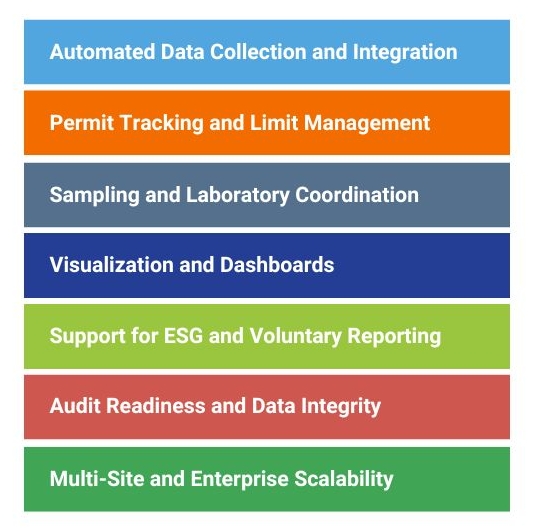
-
Automated Data Collection and Integration
The best tools integrate directly with:
- Flow meters and SCADA systems.
- Laboratory Information Management Systems (LIMS) and/or EDDs.
- Enterprise Resource Planning (ERP) and business intelligence tools.
- Existing EHS and sustainability platforms.
Centralizing all data in a secure cloud platform ensures consistency, reduces manual entry, and improves confidence in reporting accuracy.
-
Permit Tracking and Limit Management
Industrial dischargers must comply with permit-specific conditions that vary by site and jurisdiction. Look for software that:
- Maps permit requirements to specific outfalls, analytes, and flow limits.
- Flags exceedances or missing data.
- Automates the preparation of Discharge Monitoring Reports (DMRs).
- Maintains historical data for audits and renewals.
This ensures that compliance is embedded directly into daily operations, not just checked at the end of the reporting cycle.
-
Sampling and Laboratory Coordination
Water sampling and lab analysis are core components of industrial compliance. Robust platforms like Locus:
- Track sample plans, events, chains of custody, and lab results.
- Provide automated QA/QC checks.
- Link lab results to relevant permits and reporting obligations.
Centralizing sample data improves visibility and traceability, which is especially important across multiple sites.
-
Visualization and Dashboards
Data alone isn’t enough. EHS teams need configurable dashboards and visual tools to:
- Monitor key metrics like water use, discharge volumes, exceedances, and trends.
- Quickly identify anomalies or operational inefficiencies.
- Share insights with management or external stakeholders.
Look for tools with graphical trend analysis, map-based views, and configurable reports and dashboards.
-
Support for ESG and Voluntary Reporting
If your organization reports to CDP, GRI, or uses SASB-aligned metrics, ensure the software:
- Aligns with these frameworks natively and can be easily configured as requirements change.
- Supports water intensity metrics (e.g., gallons per unit produced).
- Can export data in formats compatible with ESG reporting platforms or seamlessly integrates with ESG reporting software like Locus.
This enables dual-purpose reporting (regulatory and voluntary) without doubling the effort. That’s an incredibly powerful way to reallocate valuable time to all the other items on your to-do list.
-
Audit Readiness and Data Integrity
Regulators and third-party auditors expect a clear log from measurement to reporting. Your software should provide:
- User activity logs and change tracking.
- Automated version control.
- Easy-to-navigate audit histories.
Being audit-ready saves time and builds confidence in both internal and external reviews.
-
Multi-Site and Enterprise Scalability
Large industrial companies often operate across multiple sites, regions, or countries. Your chosen industrial water reporting software must:
- Support hierarchical access and role-based permissions.
- Allow site-specific workflows with centralized oversight.
- Aggregate enterprise-wide water data in one system (like Locus Water).
Scalability is especially important for organizations pursuing global or company-wide sustainability targets.
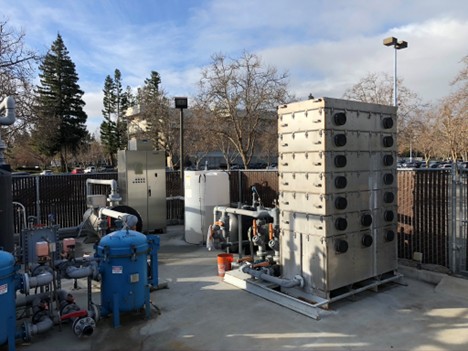
The key takeaway
Water is one of the most vital and most scrutinized resources in industrial operations. As the stakes for compliance and sustainability rise, the cost of not investing in robust water reporting tools grows with them.
For EHS professionals, adopting the right software platform isn’t just about checking a compliance box. It’s about enabling smarter decisions, reducing risk, and future-proofing operations in a world where water performance is under the spotlight. The most successful companies will be those that treat water data not as a burden, but as a strategic asset. The Locus Water suite helps enterprises make that happen.
Want to learn how leading industrial companies are transforming their water reporting with AI-powered tools? Schedule a demo with us today!
Frequently Asked Questions
Why is water reporting important for industry?
Water scarcity and resource risk, regulatory compliance, and sustainability reporting are among the main reasons water reporting matters to industry.
What types of regulations relate to industrial water?
Every organization differs, but National Pollutant Discharge Elimination System (NPDES) permits, Stormwater Pollution Prevention Plans (SWPPPs), Industrial Wastewater Discharge Permits, and state-level water use and quality regulations are frequently cited.
What are the top capabilities to look for in industrial water reporting software?
Every organization has different priorities, but the following capabilities are commonly sought from industrial water reporting software: flexible integrations to unite all data sources, permit tracking and tasking, support for samples and analytical data, spatial and visual analytics, audit controls, configurable reports, scalability and adaptability.
Neno Duplan
Founder & CEO
As Founder and CEO of Locus Technologies, Dr. Duplan spent his career combining his understanding of environmental science with a vision of how to gather, aggregate, organize, and analyze environmental data to help organizations better manage and report their environmental and sustainability footprints. During the 1980’s, while conducting research as a graduate student at Carnegie Mellon, Dr. Duplan developed the first prototype system for an environmental information management database. This discovery eventually lead to the formation of Locus Technologies in 1997.
As technology evolved and new guidelines for environmental stewardship expanded, so has the vision Dr. Duplan has held for Locus. With the company’s deployment of the world’s first commercial Software-as-Service (SaaS) product for environmental information management in 1999 to the Locus Mobile solution in 2014, today Dr. Duplan continues to lead and challenge his team to be the leading provider of cloud-based EH&S and sustainability software.
Dr. Duplan holds a Ph.D. in Civil Engineering from the University of Zagreb, Croatia, an M.S. in Civil Engineering from Carnegie-Mellon, and a B.S. in Civil Engineering from the University of Split, Croatia. He also attended advanced Management Training at Stanford University.
Locus is the only self-funded water, air, soil, biological, energy, and waste EHS software company that is still owned and managed by its founder. The brightest minds in environmental science, embodied carbon, CO2 emissions, refrigerants, and PFAS hang their hats at Locus, and they’ve helped us to become a market leader in EHS software. Every client-facing employee at Locus has an advanced degree in science or professional EHS experience, and they incubate new ideas every day – such as how machine learning, AI, blockchain, and the Internet of Things will up the ante for EHS software, ESG, and sustainability.

